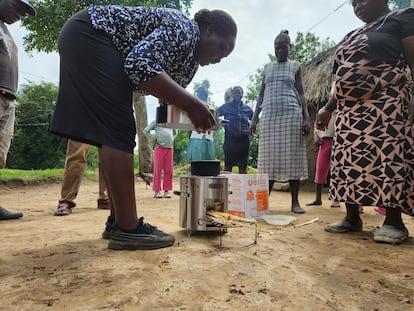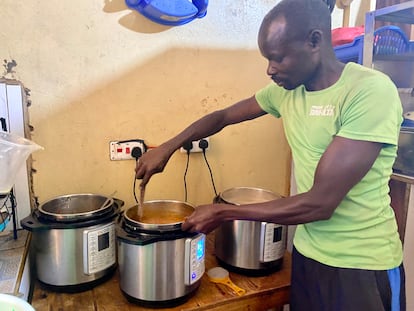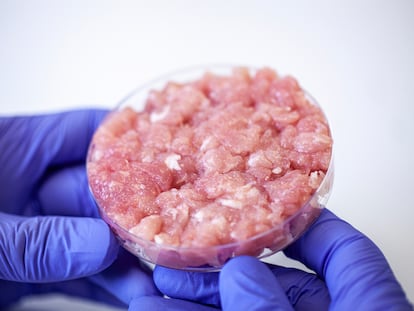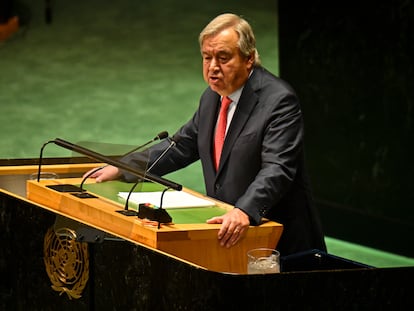Sustainable kitchens pay for themselves by saving forests
Four million people die each year from diseases related to the use of wood or charcoal at home. Some companies are now beginning to use carbon credits to finance newer, safer and more efficient ways of cooking

Bernard Okaal proudly shows off his three electric pots. On one stove, he’s making tea with milk. In another, beans. And, in the third, a tripe stew is simmering. “Before, everything would fill up with smoke,” he remembers, as he stirs the dishes in his take-out restaurant in Kiambu, a town located about nine miles from Nairobi, the Kenyan capital. For about 120 Kenyan shillings (just under 80 cents) you can buy a container of beans, cabbage and chapati. And you can get it without any pollution. “Fresh air is best,” Okaal smiles.
Okaal, 50, was laid off from his job as a chef in a hotel during the pandemic. He subsequently decided to make a living by opening his business, where he employs three people and prepares nearly a hundred meals every day. Last year, he purchased the first electric cooker from BURN, a company that produces cleaner, more efficient cooking systems.
“Before, I paid about 1,300 shillings (almost $8) in gas to cook for a whole day. Now, I pay about 500 in total (about $4) to use the pots and the refrigerator,” he notes. He has also cut down the average cooking time for each meal, he explains, as the classic systems of cooking — on a wood-burning stove or on stones — were very inefficient. Okaal is so enthusiastic that he has already bought two electric cookers from BURN, each for about 12,000 shillings (about $80). He’s able to pay in small instalments of just over $3 each week.
The pots actually cost much more, explains Chris McKinney, the company’s commercial director. However, he and other companies are managing to lower prices by using a new tool: carbon bonds or credits. With this system, a country or a community can commit to preserving strategic forests for the climate crisis, in exchange for offering financing to companies or countries that want to offset their carbon emissions.
This system often receives criticism from environmentalists for “greenwashing” — covering up the use of fossil fuels with other initiatives — and for the lack of vigor surrounding the projects that are financed. But, thanks to carbon credits, McKinney maintains, efficient cooking pots such as the ones sold by BURN can drastically go down in price. These savings go a long way in a country like Kenya, where the minimum wage is 15,120 shillings (about $100) each month. And the most interesting thing about the system is that, as these stoves are more widely-used, more carbon credits are generated. Some companies are even considering starting to pay individuals to use green kitchens.

Cooking is a very serious health problem in Kenya, as with much of the rest of the globe. Some 2.4 billion people in the world cook using “inefficient” systems, according to 2022 data from the World Health Organization. These include cooking with fires that are fueled by charcoal, wood or kerosene. This is a huge environmental problem, as it generates about 2% of the globe’s annual emissions, more than the entire airline industry. These forms of cooking also contaminate the air, causing diseases that kill at least four million people each year, according to data from the Clean Cooking Alliance.
“Children are especially vulnerable,” emphasizes Amy Wickham, a climate specialist from UNICEF, during a phone interview with EL PAÍS. She cites a U.N. report, listing facts about what such pollution does to vulnerable children: “They breathe twice as fast as adults, they have weaker immune systems, [issues with] brain development… smoke at home affects the heart and lungs, but [children] also suffer cognitive damage,” she points out.
Traditional cooking also poses more problems, such as domestic accidents — pots on the makeshift stove often aren’t very stable — or, in unsafe rural areas, women have to go out daily to collect firewood, exposing themselves to danger. In addition, this type of cooking consumes a lot of time: women and children in countries across the Global South spend an average of 20 hours a week collecting material for fires, according to the U.N.
Several African countries have an especially big challenge to contend with when it comes to cooking. “The problem is getting worse here, instead of improving, because the population is growing faster than advances in clean cooking,” explains Caroline Ochieng, an expert at Sustainable Energy for All, a partner organization of the United Nations and several European governments.
“The biggest challenge is financing, because you cannot depend exclusively on the private sector,” Ochieng warns. “The majority of the population that would benefit is poor, or lives in remote locations — that is, they’re not the principal market for a company.” Ending poverty in the kitchen and switching to methods that result in less global pollution would require an investment of $7.4 billion dollars each year, affirms Wickham from UNICEF.
“I’m an optimist,” says Kip Patrick, senior director of communications at the Clean Cooking Alliance. “In the 10 years that I’ve been working in this sector, I’ve never seen so many people talking about prioritizing clean cooking.” Patrick highlights that the Kenyan government has just announced a team specifically dedicated to clean cooking. President William Ruto’s administration has set the goal of reaching 100% clean cooking in the country by 2028, betting — above all — on liquefied petroleum gas (LPG). But LPG often comes at a price that’s unaffordable for lower-income consumers. Jon Leary, a researcher at Modern Energy Cooking Services (MECS), a kitchen transformation program funded by the UK government, explains that, unlike LPG, coal or kerosene can be purchased on a daily basis in very small quantities.
There’s another system that’s increasingly spreading in different African countries, known as “pay as you cook.” This implies buying only the amount of gas that you need (and can afford) for the day. The system is also applied to electric cooking: while it’s only used by a very small minority, it represents great savings for the domestic economy.
“Electricity is usually perceived as much more expensive than other sources of energy, but that’s because cheap and very inefficient appliances are often used,” Leary clarifies. “You also run into the problem that electric pressure cookers or induction cookers have a much higher [cost of purchase], despite being much cheaper in the long run.”
Paying in small weekly or monthly installments can help overcome these fears. Bernard Okaal, Kiambu’s cook, is already planning to buy another pot as soon as he finishes paying off what he owes.
Sign up for our weekly newsletter to get more English-language news coverage from EL PAÍS USA Edition
Tu suscripción se está usando en otro dispositivo
¿Quieres añadir otro usuario a tu suscripción?
Si continúas leyendo en este dispositivo, no se podrá leer en el otro.
FlechaTu suscripción se está usando en otro dispositivo y solo puedes acceder a EL PAÍS desde un dispositivo a la vez.
Si quieres compartir tu cuenta, cambia tu suscripción a la modalidad Premium, así podrás añadir otro usuario. Cada uno accederá con su propia cuenta de email, lo que os permitirá personalizar vuestra experiencia en EL PAÍS.
¿Tienes una suscripción de empresa? Accede aquí para contratar más cuentas.
En el caso de no saber quién está usando tu cuenta, te recomendamos cambiar tu contraseña aquí.
Si decides continuar compartiendo tu cuenta, este mensaje se mostrará en tu dispositivo y en el de la otra persona que está usando tu cuenta de forma indefinida, afectando a tu experiencia de lectura. Puedes consultar aquí los términos y condiciones de la suscripción digital.
More information

How sustainable are fake meats?
Archived In
Últimas noticias
Most viewed
- Sinaloa Cartel war is taking its toll on Los Chapitos
- Oona Chaplin: ‘I told James Cameron that I was living in a treehouse and starting a permaculture project with a friend’
- Reinhard Genzel, Nobel laureate in physics: ‘One-minute videos will never give you the truth’
- Why the price of coffee has skyrocketed: from Brazilian plantations to specialty coffee houses
- Silver prices are going crazy: This is what’s fueling the rally










































